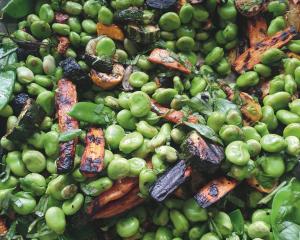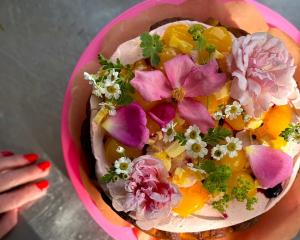Beautiful creamy curds cradled by strong green leaves make cauliflower one of the most intriguing vegetables.
However, it's an often overlooked member of the cabbage family, usually playing second fiddle to its flagrant green cousin, broccoli.
Cauliflower is thought to have originated around the eastern Mediterranean and now can be found in green and purple forms as well as white.
Like all brassicas, it's a nutrient powerhouse, containing compounds thought to inhibit the development of some cancers, as well as vitamins C, K and B, folate, and various minerals.
Look for tight, ivory-coloured curds protected by fresh green leaves.
Avoid damaged, yellowing or separating curds and wilting leaves.
Store cauliflower no more than three or four days in the fridge in a plastic bag.
Cauliflower's light, creamy flavour and ability to be served raw, cooked lightly so it's still crunchy, or cooked longer until meltingly soft means it is hugely versatile.
Cauliflower can be steamed, boiled lightly, microwaved or stir-fried (it's good stir-fried with finely chopped fresh ginger then seasoned and topped with a handful of fresh coriander and the juice of a lemon).
I hadn't roasted cauliflower before, but several cookbooks suggested it.
It's delicious and has now become one of my favourite ways of cooking it.
Simply toss florets or slices in a little olive oil and cook at about 190degC for about 20 minutes (depending on size) with or without other vegetables.
However, beware of overcooking cauliflower - over-boiled, it can be disgusting, the smell permeating the house.
To counteract the smell, Antonio Carluccio suggests adding a little vinegar to the cooking water, if you like soft cauliflower.
A friend mashes soft cauliflower with potato to disguise it for recalcitrant teenagers.
Of course, cauliflower doesn't actually need to be cooked.
Little florets (along with carrot sticks, celery, crisp radish and other crudites) are good with dips such as hummus, baba ganoush (smoked eggplant puree) or aioli.
Cauliflower is quick to prepare - just remove the outer leaves, cut off as many florets as you need (these can be large or small, sliced or whole), rinse and steam, boil in a little water or microwave.
There's no need to cut off the floret stems - they taste good too.
A whole cauliflower makes an impressive dish.
Take off the outer leaves and cut out the woody core of the stem to help it cook evenly.
Place it stem down in a large pot in 5cm or 6cm of water, and steam for about 10 minutes.
It is done when still slightly firm when the point of a knife is inserted.
• A strongly flavoured, chunky cauliflower sauce from Sicily is served with a long pasta such as spaghetti or tagliatelli:Soften a chopped onion and five or six finely chopped anchovies in some extra virgin olive oil, add a pinch of saffron (optional), a can of chopped tomatoes in juice or two or three tablespoons of tomato purée, a couple of handfuls each of pine nuts and currants or raisins.
Season with pepper and salt if needed (anchovies are salty) and simmer.
Add lightly cooked cauliflower - you need smallish pieces.
Thin the sauce with a little cauliflower or pasta cooking water if needed.
Toss through cooked pasta and sprinkle with toasted breadcrumbs or grated Parmesan. (To make toasted breadcrumbs, either whizz a broken slice of crisp toast, or whizz a slice of bread into crumbs and stir in a hot frying pan with or without a little oil, or spread on a tray in a hot oven until crisp.)
• For something completely different, serve lightly roasted or fried cauliflower florets with a Southeast Asian sweet hot and sour dressing - chop a clove of garlic, one or two hot red chillies, a handful of mint leaves, and mix with a couple of tablespoons each of caster sugar and fish sauce, the juice of a lime and its chopped skin, and mix with a tablespoon of water.
Cauliflower cheese is a classic dish but made the traditional way with butter, milk and lashings of cheese (best for flavour are Gruyere and Parmesan), it's not a particularly healthy everyday dish.
However, if you use low-fat milk and a flavoursome cheese - so you don't need as much - and add some breadcrumbs to the cheese topping for crunch, it will keep down the fat content.
A beaten egg whisked into the sauce, some mustard and a good grating of nutmeg will help enrich the dish.
Rosemary Stanton in her excellent Vegetables (2000) suggests steaming about 500g cauliflower (whole or in pieces).
Melt 1 Tbsp butter and stir in 1 Tbsp flour and tsp dry mustard.
After cooking for two minutes, stir in about 300ml skim milk until the sauce thickens.
Takes it off the heat, stir in a beaten egg and 1 Tbsp grated Parmesan and nutmeg if you like.
Pour the sauce over the cauliflower in a baking dish, top with cup grated Gruyere, breadcrumbs whizzed up from a slice of bread, and some chopped parsley.
Bake or fan-grill for about 10 minutes at 190degC until the cheese is melted and breadcrumbs crunchy.
A simpler version of cauliflower cheese without a sauce comes from Italy.
Soften a chopped clove of garlic or two in extra virgin olive oil over medium heat, drizzle over lightly cooked cauliflower and sprinkle over a generous topping of grated pecorino or Parmesan, mixed with breadcrumbs if you like; season with salt and pepper then bake or fan-grill until the cheese is crusty and golden.
Sprinkle with chopped parsley.
There are many versions of cauliflower soup, some with coconut milk and many spices and others with cream and stock, but I couldn't help being intrigued by a quick, simple version adapted from Stephanie Alexander's magisterial The Cook's Companion (2000).
Like all simple recipes, the result depends on the quality of the ingredients so use a good chicken stock, preferably homemade or in a Tetrapak rather than powdered.
Cook chopped cauliflower in chicken stock to cover.
When softened, purée and add half a teaspoon (or to taste) of Marmite or Vegemite, season with pepper, a little salt, finely chopped parsley and serve with a generous topping of grated Parmesan.
Something special
Lightly cooked cauliflower, whole or in pieces, can become something special by finishing it in one of the following ways.
They are all good hot, warm or cold.
Whizz a slice of grainy bread and a clove of garlic to make garlic crumbs.
Brown in a pan in some hot extra virgin olive oil then stir in the cauliflower pieces and sprinkle with chopped parsley.
Heat some extra virgin olive oil in a pan and slowly soften chopped onion, garlic, four or five finely chopped anchovies, capers, olives, and perhaps a dried chilli.
Drizzle the lot over cauliflower and season with freshly ground pepper and parsley.
Cook a chopped clove of garlic and a teaspoon or so of fennel seeds in some extra virgin oil, add a chopped tomato or two, or half a tin of tomatoes or some tomato paste, and cook for a few moments.
Stir in the lightly cooked cauliflower and simmer to heat through.
Brown some sliced spicy sausage in a little olive oil, add a pinch of chilli powder and some wine to moisten.
Stir in the cauliflower.
Toss florets in hot canola oil with a handful of sunflower seeds and half to one teaspoon of garam masala.
Toss steamed cauliflower in hot oil, drain and sprinkle over a mix of 1 tsp ground coriander, tsp ground cumin, tsp ground fennel, freshly ground black pepper, salt and sprinkle with lemon juice.
Aloo gobi - cauliflower and potato curry
We enjoyed many versions of this throughout India.
There are probably as many recipes for it as there are Indian cooks, but this is a comforting and quick one I cook at home.
You can use more or less potato and cauliflower depending on how many you are feeding and if you are serving other dishes as well.
2-3 Tbsp oil
1 tsp black or brown mustard seeds
1 onion, chopped
2-4 cloves of garlic, chopped finely
A thumb-sized piece of fresh ginger root, chopped finely
2 fresh or dried hot red chillies chopped (deseeded if you like), or you can use -1 tsp flaked chilli or cayenne pepper to taste
1 tsp ground cumin
1 tsp turmeric
2 tsp ground coriander
1 tsp nigella (also known as kalonji or black onion seed, optional)
About 2 large potatoes scrubbed and chopped into small pieces
About large cauliflower, chopped into florets
1 tin (about 400g) tomatoes in juice (or chopped fresh tomatoes or tomato purée)
about 1 tsp salt or to taste
To serve:Thick, plain unsweetened yoghurt
Chopped fresh coriander or parsley
Rice or flat bread such as naan
Heat oil and add the mustard seeds.
Put a lid on the pan immediately as they will pop and leap out.
As soon as they start to do so (you will hear them), add the chopped onion and stir (that quietens them).
Then add the rest of the spices and stir for a few minutes to cook.
Add the potatoes, cauliflower and tomatoes, breaking up the tomatoes as you stir.
Bring to the boil, lower the heat and simmer until the potato and cauliflower are tender and the sauce thickened - about 15 minutes if you are in a hurry or longer to develop the flavours.
Add water if it looks a bit dry and likely to catch.
Season to taste with salt.
Top with a dollop of yoghurt and a handful of fresh herbs.
Serve with rice or warm flat bread.











